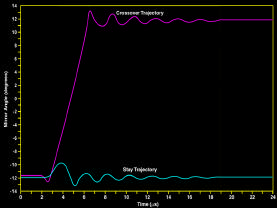Hi !
1. the Figure 6 shows that the mirror transition and settle time is 18us, and the time that the tilt angle of the mirror transit from -12 to +12 is about 3us. If I want to change the 3us to 12us ,in other words , to make the red line rise slowly in Figure 6,what should I do ? If there any method? The product that I want to use of TI is DLP5500.
2. When the reset signal drive a row of micromirror to change their mechanical position simultaneously, I want to know the time difference between a micromirror and the next one in a row. Is the time difference less then 1ns ?
3. If there same DMDs can be drove to change their mechanical position simultaneously in the diagonal direction like showed in Figure 7 ?
Thank you !


